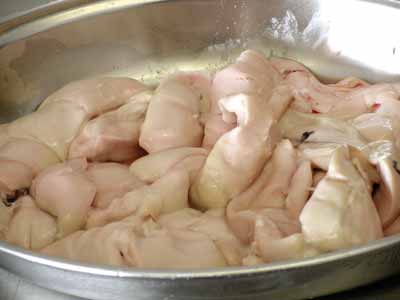
Soft roe often come from tuna in the south or Europe or herring in the north. Soft roe consists of the sperm or semen of a male fish which lie along the body cavity and can be lifted out. Popularly soft roes are air-dried and then sliced very thinly and served with olive oil or dipped in flour and fried.
The soft shell clam or longneck is a type of small clam ideal for steaming, frying and as part of a clam bake. It has a thin brittle shell which is easily broken so care must be taken in handling them. It lives about 18-25 cm (7-10”) under the surface of tidal mudflats. As they hold their siphons aloft and use them to draw in seawater from which food is filtered, and the waste is then expelled, it is sometimes possible to spot where a clam might be buried. This is the clam classically the target of the clam dig and these holes help a great deal in the process. Applying pressure to the mud can encourage the clam to send up a spit of water, making them easier to locate. When caught it is recommended to let them clean up in some saltwater for a few days and adding cornmeal to the water is said to facilitate this process.

can be one of many species of crab, and in the United States, typically blue crab, which, during its molt, is caught and prepared for eating whole, grilled, broiled, dusted with flour, or battered and fried. Soft-shell crabs offer abundant delicate crab flavor without the need to break through and clean them of the hard crab shell. As crabs of differing species grow, they fatten to break through their hard shells and as they are preparing to shed the old one, a new, roomier, and pliant shell grows underneath. The crabs shed their old shells over a period of several hours after which time the supple shell beneath hardens and this molting season occurs from the month of May to October starting with the month’s full moon. A soft-shell crab must be harvested during those critical couples of hours before the new shell becomes rigid. Thus, crabs are caught and held in tanks just prior to the actual molt. The season, although plentiful, is short and in the sister cities of Baltimore and New Orleans, can be found on many a menu.